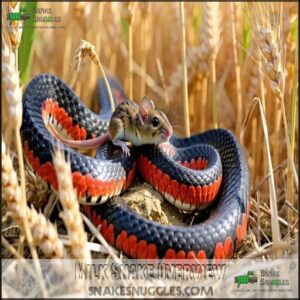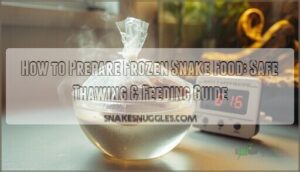This site is supported by our readers. We may earn a commission, at no cost to you, if you purchase through links.
 You’ll find milk snakes throughout North and Central America, recognized by their distinctive red, black, and yellow (or white) bands.
You’ll find milk snakes throughout North and Central America, recognized by their distinctive red, black, and yellow (or white) bands.
Despite their name, they don’t actually drink milk—this myth originated from farmers spotting them in barns where they hunted rodents.
These non-venomous constrictors are often confused with coral snakes, though you can tell them apart using the rhyme "red touch yellow, kill a fellow; red touch black, friend of Jack."
Milk snakes make surprisingly docile pets, typically growing 2-4 feet long with a lifespan of 15-20 years.
Their amazing mimicry system has evolved for a reason that might surprise you.
Table Of Contents
- Key Takeaways
- Milk Snake Overview
- Milk Snake Habitat
- Milk Snake Behavior
- Milk Snake Care and Health
- Milk Snakes as Pets
- Frequently Asked Questions (FAQs)
- How poisonous is a milk snake?
- What happens if a milk snake bites you?
- Are milk snakes friendly pets?
- How big do milk snakes get?
- Why do they call them milk snakes?
- Where do milk snakes live in the US?
- Are milk snakes friendly to humans?
- What is the lifespan of a milk snake?
- Why is milking snakes at home not useful?
- Do milk snakes eat rattlesnakes?
- Conclusion
Key Takeaways
- Milk snakes aren’t venomous despite their mimicry of coral snakes, and you can identify them using the rhyme "red touch yellow, kill a fellow; red touch black, friend of Jack."
- You’ll find milk snakes across North and South America in diverse habitats from forests to agricultural areas, where they help control rodent populations—not drink milk from cows as their name misleadingly suggests.
- These reptiles make surprisingly docile pets with proper care, typically growing 2-4 feet long and living 15-20 years in captivity with the right temperature gradient (75-85°F) and humidity levels.
- You’ll need to provide milk snakes with proper enclosures (at least 40-gallon tanks for adults), multiple hiding spots, and appropriate substrate like aspen bedding or cypress mulch to mimic their natural nocturnal and secretive behavior.
Milk Snake Overview
You’ll find milk snakes (genus Lampropeltis) across North and South America, where they’re often mistaken for venomous coral snakes due to their similar red, black, and white banded patterns.
Despite their name coming from an old folktale about stealing milk from cows, these non-venomous constrictors actually help farmers by controlling rodent populations in agricultural areas.
Classification and Taxonomy
The evolution of milk snake classification reveals a complex taxonomic history. You’ll find these fascinating reptiles in the kingdom Animalia and family Colubridae, with the scientific name Lampropeltis triangulum.
Originally grouped as a single species with 25 subspecies, recent genetic studies have sparked debate among scientists. Some researchers now propose splitting milk snakes into seven distinct species, highlighting how our understanding of snake taxonomy continues to evolve through advanced research.
They belong to the same genus, and share genetic similarities with kingsnakes, which is a key aspect of their biological classification and helps in understanding their taxonomic relationships.
Physical Characteristics
Now that you understand their classification, let’s explore what milk snakes actually look like.
With lengths ranging from 14 to 69 inches, these reptiles display stunning scale patterns consisting of vibrant red, black, and white bands.
With lengths ranging from 14 to 69 inches, these reptiles display stunning scale patterns consisting of vibrant red, black, and white bands.
Their smooth, shiny scales and mimicry markings often confuse predators (and humans!) with venomous coral snakes.
Unlike some species, milk snakes show minimal sexual dimorphism, with males and females sharing similar snake morphology.
Habitat and Distribution
The impressive geographic range of milk snakes stretches from southeastern Canada to Venezuela, making them one of North America’s most widely distributed serpents.
These adaptable reptiles thrive in diverse habitats:
- Forests and woodlands where they hide under leaf litter
- Rocky outcroppings and grasslands at varying altitudinal ranges
- Agricultural areas and even suburban neighborhoods with suitable microhabitat preferences
You’ll find these mimics have adapted remarkably well to both wild environments and human-altered landscapes.
Milk Snake Habitat
You’ll find milk snakes across North and South America in diverse environments from forests and rocky hillsides to agricultural fields and even suburban neighborhoods.
They’re highly adaptable creatures that thrive in various habitats by seeking shelter under logs, rocks, or in abandoned rodent burrows during daylight hours, which makes them highly successful in different ecosystems.
Geographic Range
You’ll find milk snakes across one of the widest geographic ranges of any snake in North America.
These adaptable reptiles stretch from southeastern Canada through the United States and into Venezuela.
Different subspecies have carved out territories based on habitat variation and climate influence.
Some populations even overlap with their coral snake lookalikes, reinforcing their mimicry advantage.
Natural dispersal barriers like mountains and rivers have helped create the 24 distinct subspecies we recognize today.
Environmental Adaptations
Through remarkable adaptations, milk snakes thrive in diverse habitats from dense forests to dry grasslands.
They’ve evolved temperature regulation strategies that allow them to brumate during cold winters and become active at night when it’s cooler.
Their famous mimicry survival technique—sporting vibrant bands similar to venomous coral snakes—deters predators effectively.
These behavioral adaptations, combined with their habitat preferences for hiding spots like logs and rocky crevices, guarantee their survival across varied ecosystems.
Agricultural Areas and Human Interaction
Milk snakes’ preference for agricultural areas stems from their natural role in rodent control.
You’ll often find these beneficial reptiles in barns, particularly dairy barns, where they hunt mice and rats.
Here’s why milk snakes thrive near humans:
- They consume 15-20 rodents monthly
- Their presence reduces crop damage
- They don’t damage farm structures
- They’re non-venomous and shy
- Conservation status remains stable despite human impact
Snake relocation programs help maintain their populations when human interaction becomes necessary, which is crucial for their conservation status and allows them to continue their beneficial role in agricultural areas.
Milk Snake Behavior
You’ll find milk snakes are primarily nocturnal creatures, becoming most active during dusk and nighttime when they hunt for prey and explore their surroundings.
These solitary reptiles spend their days hidden under logs, rocks, or in burrows, emerging only when temperatures cool to search for rodents, birds, lizards, and even other snakes to constrict and consume.
Nocturnal Habits
Hidden during daylight hours, milk snakes emerge as true nocturnal creatures when darkness falls.
You’ll rarely spot these secretive reptiles in open areas during the day, as they practice predator avoidance by sheltering under rocks, logs, or in burrows.
Their sensory adaptations include specialized heat detection and a remarkable sense of smell, using their flickering tongues to navigate through their snake habitats during nighttime hunting activities.
Hunting Techniques and Prey
The silent constriction methods of milk snakes make them efficient nocturnal hunters.
As carnivorous predators, they wrap tightly around prey until it suffocates before swallowing it whole.
Their diet includes a remarkable prey variety—from mice and rats to birds, eggs, and even other snakes.
Juveniles typically start with smaller fare like invertebrates before graduating to rodents.
You’ll find these skilled hunters providing natural rodent control in agricultural areas.
Milk snakes, however, aren’t limited to rodents, as their diet also depends on seasonal prey availability, which can be a key factor in their hunting success.
Social Interactions and Brumation
While milk snakes spend most of their lives as solitary hunters, they do gather during specific seasons.
Their social calendar revolves around brumation—a reptilian version of hibernation.
During colder months, you’ll find these typically independent creatures sharing communal dens with surprising roommates:
- Fellow milk snakes huddling for warmth
- Other snake species joining the winter retreat
- Brumation length varying from 2-5 months depending on temperature impact
- Emergence timed perfectly with mating season
- Specific den sites used year after year, creating generational gathering spots
Milk Snake Care and Health
You’ll need a proper enclosure with specific heating, substrate, and lighting conditions to keep your milk snake healthy and thriving.
Maintaining consistent temperatures between 75-85°F and providing regular veterinary check-ups will help prevent common ailments such as respiratory infections and parasites.
Enclosure and Substrate Requirements
Now that you understand their nocturnal nature, let’s look at their home setup.
Your snake enclosure should be at least a 40-gallon tank for adults. Choose substrate types like aspen bedding or cypress mulch that maintain 40-60% humidity levels.
Include multiple hiding spots to mimic their natural behavior. A suitable enclosure must be sealed and escape-proof to prevent escapes.
Proper enrichment ideas like branches and caves help with snake acclimation to captivity, ensuring your milk snake feels secure in its new environment.
Heating and Lighting Needs
With your substrate properly set up, it’s time to create the right climate in your snake enclosure.
Milk snakes need proper temperature regulation to thrive:
- A temperature gradient from 75-80°F on the cool side to 85-88°F at the basking spot
- Nighttime heat dropping to 70-75°F to mimic natural conditions
- UVB lighting isn’t required but provides a natural day/night cycle
- Heat source safety is critical—always use thermostats and guards to prevent burns.
Many owners purchase a reptile habitat thermostat for this purpose.
Common Health Issues and Prevention
Vigilance is key to preventing common milk snake health issues.
Staying alert to subtle signs keeps these vibrant reptiles thriving in captivity.
Watch for signs of respiratory infections, mouth rot, and scale rot, which often result from poor enclosure conditions.
Shedding problems can indicate inadequate humidity levels.
Regular parasite control through fecal testing helps maintain your snake’s health.
Most disease prevention comes down to proper husbandry and prompt snake veterinary care when symptoms appear, which is crucial for overall snake health.
Milk Snakes as Pets
You’ll find that milk snakes make excellent pets due to their vibrant coloration, manageable size, and relatively simple care requirements.
They adapt well to captivity and don’t require the extensive space or specialized equipment that many other exotic reptiles need, making them a relatively simple choice with vibrant coloration.
Choosing a Pet Milk Snake
Patience becomes your ally when selecting from the 24 milk snake subspecies for your reptile collection.
These beginner snakes typically display gentle temperaments, though babies may initially be nervous during handling.
Consider ethical considerations like origin and health before purchasing. Look for captive-bred snake morphs with clear eyes and smooth skin.
You’ll find most subspecies adapt well to proper enclosure enrichment and consistent snake care routines. Their vibrant colors are a key reason they’re popular, often mimicking coral snakes.
Honduran Milk Snake Care
Honduran Milk Snakes make stunning pets, but they require specific care.
They need enclosures without escape routes and a temperature gradient with regulated heat.
For proper snake care, maintain humidity between 40-50% with a water dish large enough for soaking.
Young snakes can be squirmy and may defecate when handled, so approach with patience.
Consider specialized snake products for superior care.
Use poplar bed or coconut-based substrate and clean it regularly to prevent health issues.
Eastern Milk Snake Care
While Honduran milk snakes display vibrant tricolor patterns, Eastern milk snakes require equally attentive care but with slight variations. You’ll find they’re excellent beginner reptiles with modest needs.
For proper Eastern milk snake care in captivity:
- Provide a 20-gallon enclosure minimum, larger for adults
- Maintain proper temperature gradient (75-82°F cool side, 88-92°F basking area)
- Establish a consistent feeding schedule of appropriately-sized frozen rodents
- Handle with care to develop calm temperament
- Monitor shedding problems by maintaining proper humidity
A suitable habitat includes the proper milk snake enclosure, which is essential for proper care and ensuring the snake’s overall health and well-being.
Frequently Asked Questions (FAQs)
How poisonous is a milk snake?
Milk snakes aren’t poisonous at all. They’re non-venomous constrictors often mistaken for coral snakes due to their similar coloration. You’ve got nothing to fear from these harmless, rodent-eating reptiles.
What happens if a milk snake bites you?
If a milk snake bites you, you’ll only experience minor pain and possible tiny puncture wounds.
Since they’re non-venomous, there’s no poisoning risk.
Clean the bite with soap and water as a precaution.
Are milk snakes friendly pets?
You’ll find these snakes can become quite docile with regular handling. They’re generally good-natured pets that aren’t aggressive, though they may be shy initially. With time, they’ll tolerate handling well.
How big do milk snakes get?
Would you believe these slithering beauties can grow quite impressively?
You’ll find milk snakes ranging from 14 to 69 inches in length, with most in the US and Canada reaching around 51 inches when fully grown.
Why do they call them milk snakes?
They’re called milk snakes due to an old farmer’s tale that claimed these snakes would drink milk from cows.
This myth is completely false – they actually hunt rodents in barns instead.
Where do milk snakes live in the US?
In the US, you’ll find these colorful serpents throughout the eastern states from Maine to North Carolina, and across various regions nationwide.
They adapt well to woodlands, fields, and even agricultural areas.
Are milk snakes friendly to humans?
Like shy friends at a new school, milk snakes aren’t naturally affectionate but they’ll tolerate handling once accustomed to you.
They’re generally docile, non-venomous, and rarely bite unless stressed or threatened.
What is the lifespan of a milk snake?
You can expect your milk snake to live 12-15 years in the wild.
While captive specimens often reach 15-20 years with proper care.
Some exceptional pets have even lived beyond 25 years!
Why is milking snakes at home not useful?
Despite the old wives’ tale, you’re barking up the wrong tree trying to milk snakes at home.
They don’t produce milk like mammals do—they’re reptiles without mammary glands to extract milk from.
Do milk snakes eat rattlesnakes?
Yes, milk snakes do eat rattlesnakes.
As opportunistic predators, they’ll constrict and consume smaller venomous snakes, including rattlesnakes.
Their immunity to certain snake venoms allows them to safely prey on these dangerous reptiles.
Conclusion
Whether they’re slithering through forest floors or curled up in captivity, milk snakes captivate with their striking bands and remarkable adaptations.
You’ll appreciate these resourceful creatures for their pest control abilities and docile temperament as pets.
Their evolutionary mimicry of venomous coral snakes offers a fascinating glimpse into nature’s survival strategies.
With proper care, milk snakes can be fascinating companions for nearly two decades, and they’re living examples of nature’s ingenious design.















